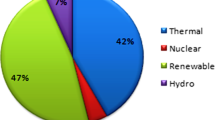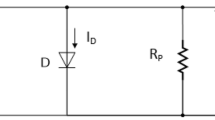Abstract
When photovoltaic (PV) arrays are subjected to partial shading conditions, the energy generated by the entire system diminishes with the appearance of multiple peaks in the P–V characteristics. A novel configuration for PV modules (PVMs) in an array has been put forth in this paper that aims to increase the output power generated by the array under partial shading conditions. This configuration involves the physical arrangement of PVMs as per the novel irregular SuDoKu (IRS) puzzle pattern connected to each other in a total cross-tied (TCT) arrangement. The electrical connections between the PVMs remain undisturbed in accomplishing this arrangement. The shading effect on PVMs within any single row is significantly reduced by this arrangement of PVMs which, in turn, increases the power generated by the PV array (PVA). Modeling and validations of these PVA configurations (PVACs) are done using MATLAB/SIMULINK. The considered PVACs are evaluated by taking numerous performance factors (i.e., mismatch power losses, efficiency, global maximum power point (GMPP) and the fill factor (FF)). The results of the proposed IRS arrangement are compared with TCT and recently proposed configurations such as SuDoKu, optimalA SuDoKu, Futoshiki SuDoKu, optimalB SuDoKu, improved SuDoKu, modified SuDoKu, hyper SuDoKu and multi-diagonal SuDoKu. The GMPP, FF and efficiency are the highest for the IRS method, with the values being 5894.4 W, 71.88% and 14.08%, respectively. Hence, the IRS is the best method in comparison with the other listed reconfiguration techniques.
















Similar content being viewed by others
Abbreviations
- β:
-
Number of cells connected in series
- \(e\) :
-
Electron charge
- \(G\) :
-
Solar irradiance
- \({G}_{\mathrm{STC}}\) :
-
Solar irradiance at STC
- \({I}_{a}\) :
-
PVA current
- \({I}_{\mathrm{out}}\) :
-
PVM output current
- \({I}_{\mathrm{pg}}\) :
-
Photo generated current
- \({I}_{s}\) :
-
Diode reverse saturation current
- \(k\) :
-
Boltzmann’s constant
- \({R}_{\mathrm{series}}\) :
-
Series resistance of PV cell
- \({R}_{\mathrm{shunt}}\) :
-
Shunt resistance of PV cell
- \({V}_{a}\) :
-
PVA voltage
- \({V}_{\mathrm{oc}}\) :
-
PVM open circuit voltage
- \({V}_{\mathrm{out}}\) :
-
PVM output voltage
- \(T\) :
-
Junction temperature
- BL:
-
Bridge link
- FF:
-
Fill factor
- FS:
-
Futoshiki SuDoKu
- GMPP:
-
Global MPP
- HC:
-
Honeycomb
- IRS:
-
Irregular SuDoKu
- IS:
-
Improved SuDoKu
- LMPP:
-
Local maximum power point
- MPL:
-
Mismatch power losses
- MPP:
-
Maximum power point
- MS:
-
Modified SuDoKu
- OPTS:
-
OptimalB SuDoKu
- OS:
-
OptimalA SuDoKu
- PSC:
-
Partial shading condition
- PV:
-
Photovoltaic
- PVA:
-
PV array
- PVAC:
-
PVA configuration
- PVM:
-
PV module
- SP:
-
Series–parallel
- STC:
-
Standard test condition
- TCT:
-
Total cross tied
References
Wang, Y.-J.; Hsu, P.-C.: Analytical modeling of partial shading and different orientation of photovoltaic modules. IET Renew. Power Gener. 4(3), 272–282 (2010)
Gao, L.; Dougal, R.A.; Liu, S.; Iotova, A.P.: Parallel-connected solar PV system to address partial and rapidly fluctuating shadow conditions. IEEE Trans. Ind. Electron. 56(5), 1548–1556 (2009)
Patel, H.; Agarwal, V.: MATLAB based modelling to study the effects of partial shading on PV array characteristics. IEEE Trans. Energy Convers. 23(1), 302–310 (2008)
Ji, Y.H.; Jung, D.Y.; Kim, J.G.; Kim, J.H.; Lee, T.W.; Won, C.Y.: A real maximum power point tracking method for mismatching compensation in PV array under partially shaded conditions. IEEE Trans. Power Electron. 26(4), 1001–1009 (2011)
Femia, N.; Lisi, G.; Petrone, G.; Spagnuolo, G.; Vitelli, M.: Distributed maximum power point tracking of photovoltaic arrays: novel approach and system analysis. IEEE Trans. Ind. Electron. 55(7), 2610–2621 (2008)
Koutroulis, E.; Blaabjerg, F.: A new technique for tracking the global maximum power point of PV arrays operating under (PSCs). IEEE J. Photo Volta. 2(2), 184–190 (2012)
Paraskevadaki, E.V.; Papathanassiou, S.A.: Evaluation of MPP voltage and power of mc-Si PV modules in partial shading conditions. IEEE Trans. Energy Convers. 26(3), 923–932 (2011)
Woyte, A.; Nijs, J.; Belmans, R.: Partial shadowing of photovoltaic arrays with different system configurations: literature review and field test results. Sol. Energy. 74(3), 217–233 (2003)
Gautam, N.K.; Kaushika, N.D.: An efficient algorithm to simulate the electrical performance of solar photovoltaic arrays. Energy 27(4), 347–361 (2002)
Picault, D.; Raison, B.; Bacha, S.; de la Casa, J.; Aguilera, J.: Forecasting photovoltaic array power production subject to mismatch losses. Sol. Energy. 84(7), 1301–1309 (2010)
Kaushika, N.D.; Gautam, N.K.: Energy yield simulations of interconnected solar PV arrays. IEEE Trans. Energy Convers. 18(1), 127–134 (2003)
Wang, Y.J.; Hsu, P.C.: An investigation on partial shading of PV modules with different connection configurations of PV cells. Energy 36(5), 3069–3078 (2011)
Laudani, A.; Maria Lozito, G.; Lucaferri, V.; Radicioni, M.; Riganti, F.F.: On circuital topologies and reconfiguration strategies for PV systems in partial shading conditions: a review. AIMS Energy. 6(5), 735–763 (2018)
Salameh, Z.M.; Dagher, F.: The effect of electrical array reconfiguration on the performance of a PV-powered volumetric water pump. IEEE Trans. Energy Convers. 5(4), 653–658 (1990)
Nguyen, D.; Lehman, B.: An adaptive solar photovoltaic array using model-based reconfiguration algorithm. IEEE Trans. Ind. Electron. 55(7), 2644–2654 (2008)
Velasco-Quesada, G.; Guinjoan-Gispert, F.; Pique-Lopez, R.; Roman-Lumbreras, M.; Conesa-Roca, A.: Electrical PV array reconfiguration strategy for energy extraction improvement in grid connected systems. IEEE Trans. Ind. Electron. 56(11), 4319–4331 (2009)
Babu, T.S.; Ram, J.P.; Dragicevic, T.; Miyatake, M.; Blaabjerg, F.; Rajasekar, N.: Particle swarm optimization based solar PV array reconfiguration of the maximum power extraction under partial shading conditions. IEEE Trans. Sustain. Energy. 9(1), 74–85 (2018)
Patnaik, B.; Sharma, P.; Trimurthulu, E.; Duttagupta, S.P.; Agarwal, V.: Reconfiguration strategy for optimization of solar photovoltaic array under non-uniform illumination conditions. Proc Photovolt. Spec. Conf. (PVSC) 56, 1859–1864 (2011)
Parlak, K.Ş: Pv array reconfiguration method under partial shading conditions. Int. J. Electr. Power Energy Syst. 63, 713–721 (2014)
Sai Krishna, G.; Moger, T.: Reconfiguration strategies for reducing partial shading effects in photovoltaic arrays: state of the art. Sol. Energy. 182, 429–452 (2019)
Rao, P.S.; Ilango, G.S.; Nagamani, C.: Maximum power from PV arrays using a fixed configuration under different shading conditions. IEEE J. Photovolt. 2(4), 679–686 (2014)
Yadav, A.S.; Pachauri, R.K.; Chauhan, Y.K.; Choudhury, S.; Singh, R.: Performance enhancement of partially shaded pv array using novel shade dispersion effect on magic-square puzzle configuration. Sol. Energy. 144, 780–797 (2017)
Pachauri, R.; Yadav, A.S.; Chauhan, Y.K.; Sharma, A.; Kumar, V.: Shade dispersion-based photovoltaic array configurations for performance enhancement under partial shading conditions. Int. Trans. Electr. Energy Syst. 28(7), 2556 (2018)
Rani, B.I.; Ilango, G.S.; Nagamani, C.: Enhanced power generation from PV array under partial shading conditions by shade dispersion using Su Do Ku configuration. IEEE Trans. Sustain. Energy. 4(3), 594–601 (2013)
Potnuru, S.R.; Pattabiraman, D.; Ganesan, S.I.; Chilakapati, N.: Positioning of PV panels for reduction in line losses and mismatch losses in PV array. Renew. Energy. 78, 264–275 (2015)
Sahu, H.S.; Nayak, S.K.; Mishra, S.: Maximizing the power generation of a partially shaded PV array. IEEE J. Emerg. Sel. Topics Power Electron. 4(2), 626–637 (2016)
Krishna, S.G.; Moger, T.: Optimal SuDoKu reconfiguration technique for total-cross-tied PV array to increase power output under non-uniform irradiance. IEEE Trans. Energy Convers. 34(4), 1973–1984 (2019). https://doi.org/10.1109/TEC.2019.2921625
Sai Krishna, G.S.; Moger, T.: Improved SuDoKu reconfiguration technique for total-cross-tied PV array to enhance maximum power under partial shading conditions. Renew. Sustain. Energy Rev. 109, 333–348 (2019)
Kandipati, R.; Tejavathu, R.: Maximum power enhancement under partial shadings using modified SuDoKu reconfiguration. CSEE J. Power Energy Syst. 99, 1–19 (2020)
Anjum, S.; Mukherjee, V.; Mehta, G.: Advanced SuDoKu-based reconfiguration strategies for maximum power extraction from partially shaded solar photovoltaic array. ASME. J. Sol. Energy Eng. 43(6), 061003 (2021). https://doi.org/10.1115/1.4051090
Anjum, S.; Mukherjee, V.; Mehta, G.: Hyper SuDoKu-based solar photovoltaic array reconfiguration for maximum power enhancement under partial shading conditions. ASME. J. Energy Resour. Technol. 144(3), 031302 (2021). https://doi.org/10.1115/1.4051427
Rayappa, D.A.R.; Kanasottu, A.N.: An image encryption concept based solar photovoltaic array reconfiguration techniques for mismatch mitigation. Energy Sour., Part A: Recovery, Utilization, Environ. Effects. 44(1), 951–972 (2022). https://doi.org/10.1080/15567036.2022.2052383
Kanasottu, A.N.; Rayappa, D.A.R.; Rao, C.V.; Babu, T.S.: Generalized cryptographic image processing approaches using integer-series transformation for solar power optimization under partial shading. Energy Convers. Manag. 116376, 272 (2022)
Author information
Authors and Affiliations
Corresponding author
Rights and permissions
Springer Nature or its licensor (e.g. a society or other partner) holds exclusive rights to this article under a publishing agreement with the author(s) or other rightsholder(s); author self-archiving of the accepted manuscript version of this article is solely governed by the terms of such publishing agreement and applicable law.
About this article
Cite this article
Anjum, S., Mukherjee, V. Irregular SuDoKu Modeling of Solar Photovoltaic Arrays for Partial Shading Optimization. Arab J Sci Eng 48, 14977–15002 (2023). https://doi.org/10.1007/s13369-023-07864-z
Received:
Accepted:
Published:
Issue Date:
DOI: https://doi.org/10.1007/s13369-023-07864-z




